Essay: Communication Skills, Barriers, and Strategies for Youths
VerifiedAdded on 2021/06/18
|8
|1870
|47
Essay
AI Summary
This essay delves into the crucial topic of effective communication skills for youths, emphasizing their significance in personal and future development. It identifies essential skills such as listening, body language, expression, and speaking abilities, while also addressing potential barriers like language, psychological state, and physical distance. The essay categorizes these barriers and explores various types of communication, including verbal, non-verbal, written, and interpersonal methods. Furthermore, it highlights the linear model of communication and emphasizes the importance of resources like readings and peer interactions. The conclusion stresses the need for creating shared understanding and offers actionable ways to improve communication skills among youths through preparation, research, and practice. The essay provides a comprehensive overview of communication dynamics relevant to young people.
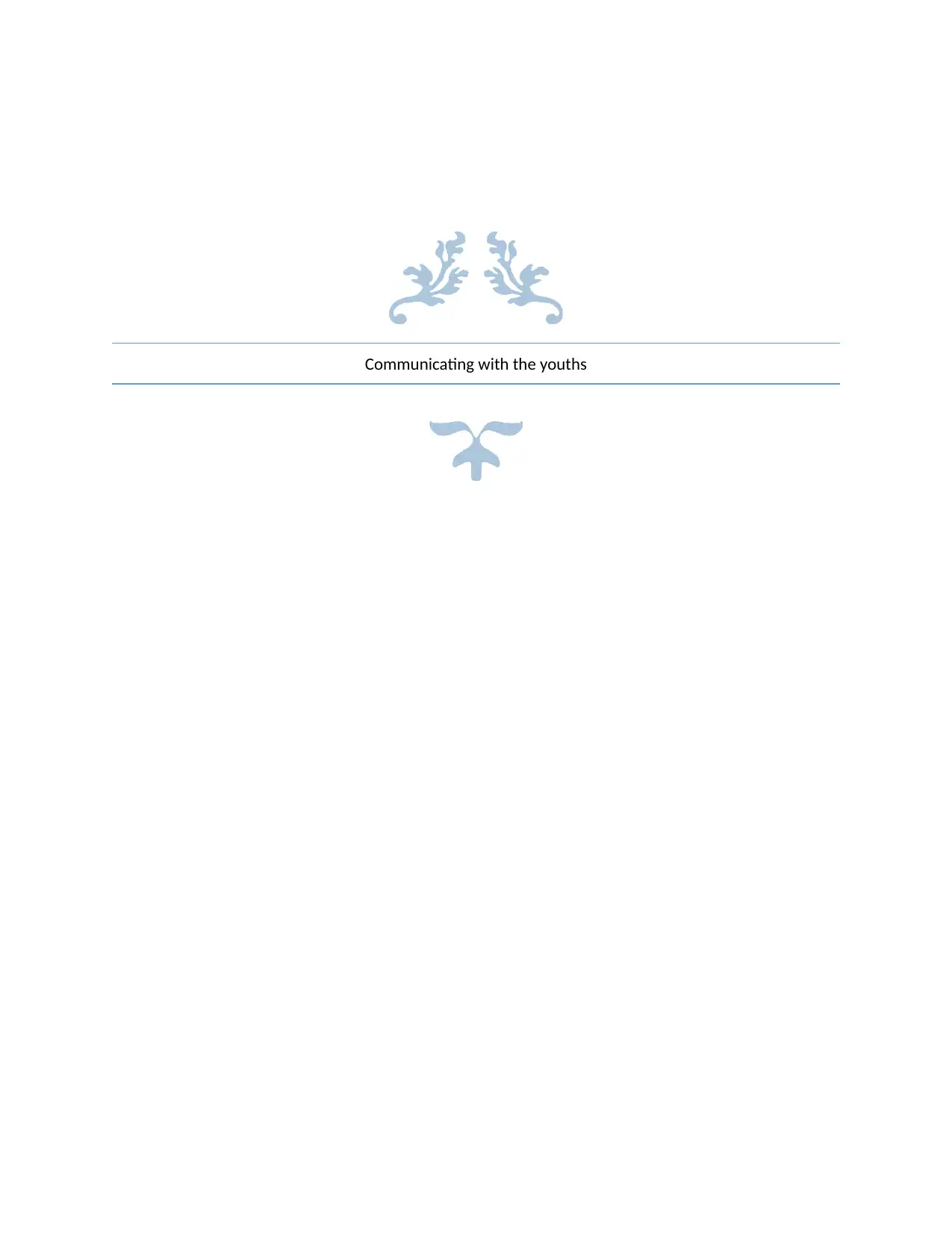
Communicating with the youths
Paraphrase This Document
Need a fresh take? Get an instant paraphrase of this document with our AI Paraphraser
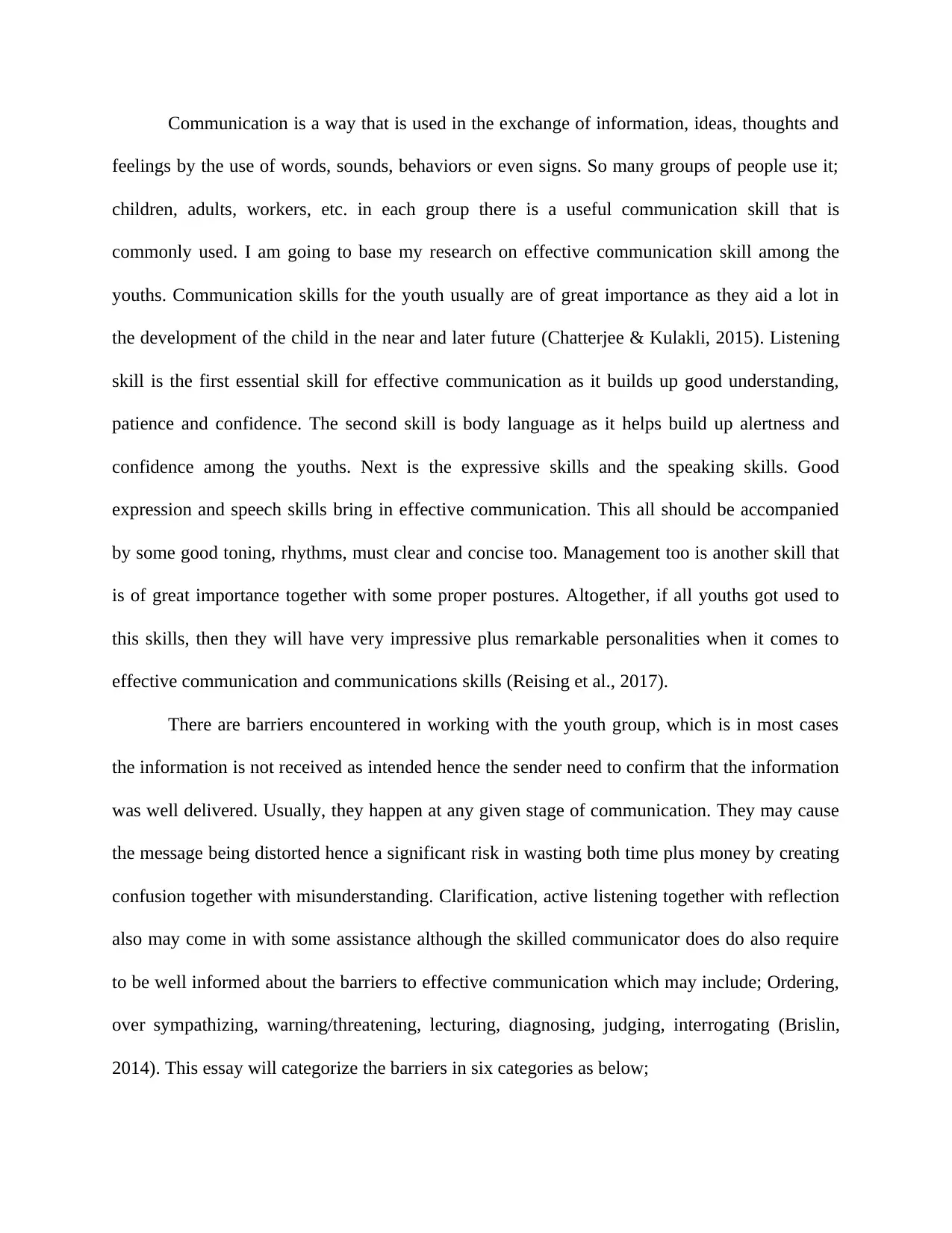
Communication is a way that is used in the exchange of information, ideas, thoughts and
feelings by the use of words, sounds, behaviors or even signs. So many groups of people use it;
children, adults, workers, etc. in each group there is a useful communication skill that is
commonly used. I am going to base my research on effective communication skill among the
youths. Communication skills for the youth usually are of great importance as they aid a lot in
the development of the child in the near and later future (Chatterjee & Kulakli, 2015). Listening
skill is the first essential skill for effective communication as it builds up good understanding,
patience and confidence. The second skill is body language as it helps build up alertness and
confidence among the youths. Next is the expressive skills and the speaking skills. Good
expression and speech skills bring in effective communication. This all should be accompanied
by some good toning, rhythms, must clear and concise too. Management too is another skill that
is of great importance together with some proper postures. Altogether, if all youths got used to
this skills, then they will have very impressive plus remarkable personalities when it comes to
effective communication and communications skills (Reising et al., 2017).
There are barriers encountered in working with the youth group, which is in most cases
the information is not received as intended hence the sender need to confirm that the information
was well delivered. Usually, they happen at any given stage of communication. They may cause
the message being distorted hence a significant risk in wasting both time plus money by creating
confusion together with misunderstanding. Clarification, active listening together with reflection
also may come in with some assistance although the skilled communicator does do also require
to be well informed about the barriers to effective communication which may include; Ordering,
over sympathizing, warning/threatening, lecturing, diagnosing, judging, interrogating (Brislin,
2014). This essay will categorize the barriers in six categories as below;
feelings by the use of words, sounds, behaviors or even signs. So many groups of people use it;
children, adults, workers, etc. in each group there is a useful communication skill that is
commonly used. I am going to base my research on effective communication skill among the
youths. Communication skills for the youth usually are of great importance as they aid a lot in
the development of the child in the near and later future (Chatterjee & Kulakli, 2015). Listening
skill is the first essential skill for effective communication as it builds up good understanding,
patience and confidence. The second skill is body language as it helps build up alertness and
confidence among the youths. Next is the expressive skills and the speaking skills. Good
expression and speech skills bring in effective communication. This all should be accompanied
by some good toning, rhythms, must clear and concise too. Management too is another skill that
is of great importance together with some proper postures. Altogether, if all youths got used to
this skills, then they will have very impressive plus remarkable personalities when it comes to
effective communication and communications skills (Reising et al., 2017).
There are barriers encountered in working with the youth group, which is in most cases
the information is not received as intended hence the sender need to confirm that the information
was well delivered. Usually, they happen at any given stage of communication. They may cause
the message being distorted hence a significant risk in wasting both time plus money by creating
confusion together with misunderstanding. Clarification, active listening together with reflection
also may come in with some assistance although the skilled communicator does do also require
to be well informed about the barriers to effective communication which may include; Ordering,
over sympathizing, warning/threatening, lecturing, diagnosing, judging, interrogating (Brislin,
2014). This essay will categorize the barriers in six categories as below;
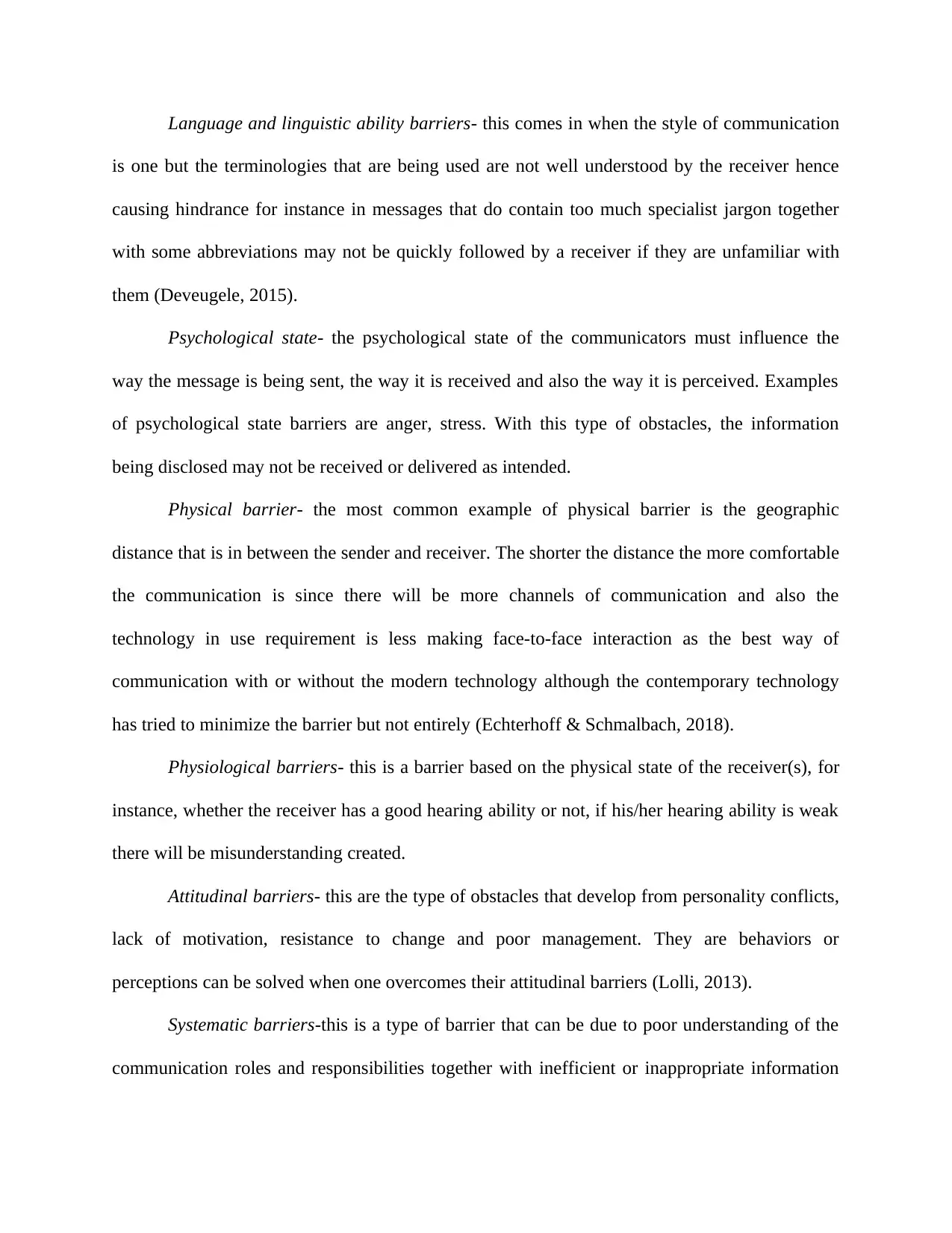
Language and linguistic ability barriers- this comes in when the style of communication
is one but the terminologies that are being used are not well understood by the receiver hence
causing hindrance for instance in messages that do contain too much specialist jargon together
with some abbreviations may not be quickly followed by a receiver if they are unfamiliar with
them (Deveugele, 2015).
Psychological state- the psychological state of the communicators must influence the
way the message is being sent, the way it is received and also the way it is perceived. Examples
of psychological state barriers are anger, stress. With this type of obstacles, the information
being disclosed may not be received or delivered as intended.
Physical barrier- the most common example of physical barrier is the geographic
distance that is in between the sender and receiver. The shorter the distance the more comfortable
the communication is since there will be more channels of communication and also the
technology in use requirement is less making face-to-face interaction as the best way of
communication with or without the modern technology although the contemporary technology
has tried to minimize the barrier but not entirely (Echterhoff & Schmalbach, 2018).
Physiological barriers- this is a barrier based on the physical state of the receiver(s), for
instance, whether the receiver has a good hearing ability or not, if his/her hearing ability is weak
there will be misunderstanding created.
Attitudinal barriers- this are the type of obstacles that develop from personality conflicts,
lack of motivation, resistance to change and poor management. They are behaviors or
perceptions can be solved when one overcomes their attitudinal barriers (Lolli, 2013).
Systematic barriers-this is a type of barrier that can be due to poor understanding of the
communication roles and responsibilities together with inefficient or inappropriate information
is one but the terminologies that are being used are not well understood by the receiver hence
causing hindrance for instance in messages that do contain too much specialist jargon together
with some abbreviations may not be quickly followed by a receiver if they are unfamiliar with
them (Deveugele, 2015).
Psychological state- the psychological state of the communicators must influence the
way the message is being sent, the way it is received and also the way it is perceived. Examples
of psychological state barriers are anger, stress. With this type of obstacles, the information
being disclosed may not be received or delivered as intended.
Physical barrier- the most common example of physical barrier is the geographic
distance that is in between the sender and receiver. The shorter the distance the more comfortable
the communication is since there will be more channels of communication and also the
technology in use requirement is less making face-to-face interaction as the best way of
communication with or without the modern technology although the contemporary technology
has tried to minimize the barrier but not entirely (Echterhoff & Schmalbach, 2018).
Physiological barriers- this is a barrier based on the physical state of the receiver(s), for
instance, whether the receiver has a good hearing ability or not, if his/her hearing ability is weak
there will be misunderstanding created.
Attitudinal barriers- this are the type of obstacles that develop from personality conflicts,
lack of motivation, resistance to change and poor management. They are behaviors or
perceptions can be solved when one overcomes their attitudinal barriers (Lolli, 2013).
Systematic barriers-this is a type of barrier that can be due to poor understanding of the
communication roles and responsibilities together with inefficient or inappropriate information
⊘ This is a preview!⊘
Do you want full access?
Subscribe today to unlock all pages.

Trusted by 1+ million students worldwide
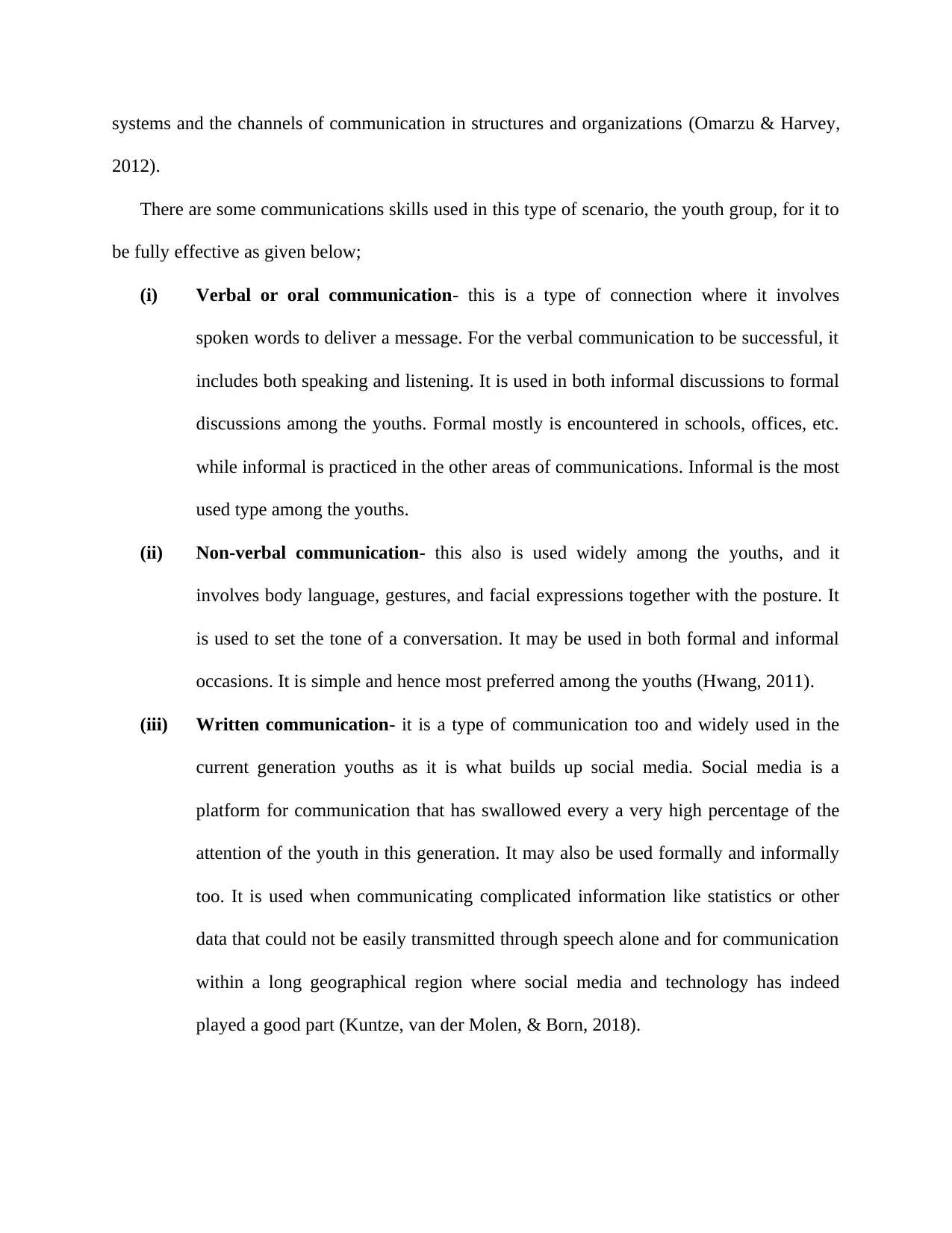
systems and the channels of communication in structures and organizations (Omarzu & Harvey,
2012).
There are some communications skills used in this type of scenario, the youth group, for it to
be fully effective as given below;
(i) Verbal or oral communication- this is a type of connection where it involves
spoken words to deliver a message. For the verbal communication to be successful, it
includes both speaking and listening. It is used in both informal discussions to formal
discussions among the youths. Formal mostly is encountered in schools, offices, etc.
while informal is practiced in the other areas of communications. Informal is the most
used type among the youths.
(ii) Non-verbal communication- this also is used widely among the youths, and it
involves body language, gestures, and facial expressions together with the posture. It
is used to set the tone of a conversation. It may be used in both formal and informal
occasions. It is simple and hence most preferred among the youths (Hwang, 2011).
(iii) Written communication- it is a type of communication too and widely used in the
current generation youths as it is what builds up social media. Social media is a
platform for communication that has swallowed every a very high percentage of the
attention of the youth in this generation. It may also be used formally and informally
too. It is used when communicating complicated information like statistics or other
data that could not be easily transmitted through speech alone and for communication
within a long geographical region where social media and technology has indeed
played a good part (Kuntze, van der Molen, & Born, 2018).
2012).
There are some communications skills used in this type of scenario, the youth group, for it to
be fully effective as given below;
(i) Verbal or oral communication- this is a type of connection where it involves
spoken words to deliver a message. For the verbal communication to be successful, it
includes both speaking and listening. It is used in both informal discussions to formal
discussions among the youths. Formal mostly is encountered in schools, offices, etc.
while informal is practiced in the other areas of communications. Informal is the most
used type among the youths.
(ii) Non-verbal communication- this also is used widely among the youths, and it
involves body language, gestures, and facial expressions together with the posture. It
is used to set the tone of a conversation. It may be used in both formal and informal
occasions. It is simple and hence most preferred among the youths (Hwang, 2011).
(iii) Written communication- it is a type of communication too and widely used in the
current generation youths as it is what builds up social media. Social media is a
platform for communication that has swallowed every a very high percentage of the
attention of the youth in this generation. It may also be used formally and informally
too. It is used when communicating complicated information like statistics or other
data that could not be easily transmitted through speech alone and for communication
within a long geographical region where social media and technology has indeed
played a good part (Kuntze, van der Molen, & Born, 2018).
Paraphrase This Document
Need a fresh take? Get an instant paraphrase of this document with our AI Paraphraser
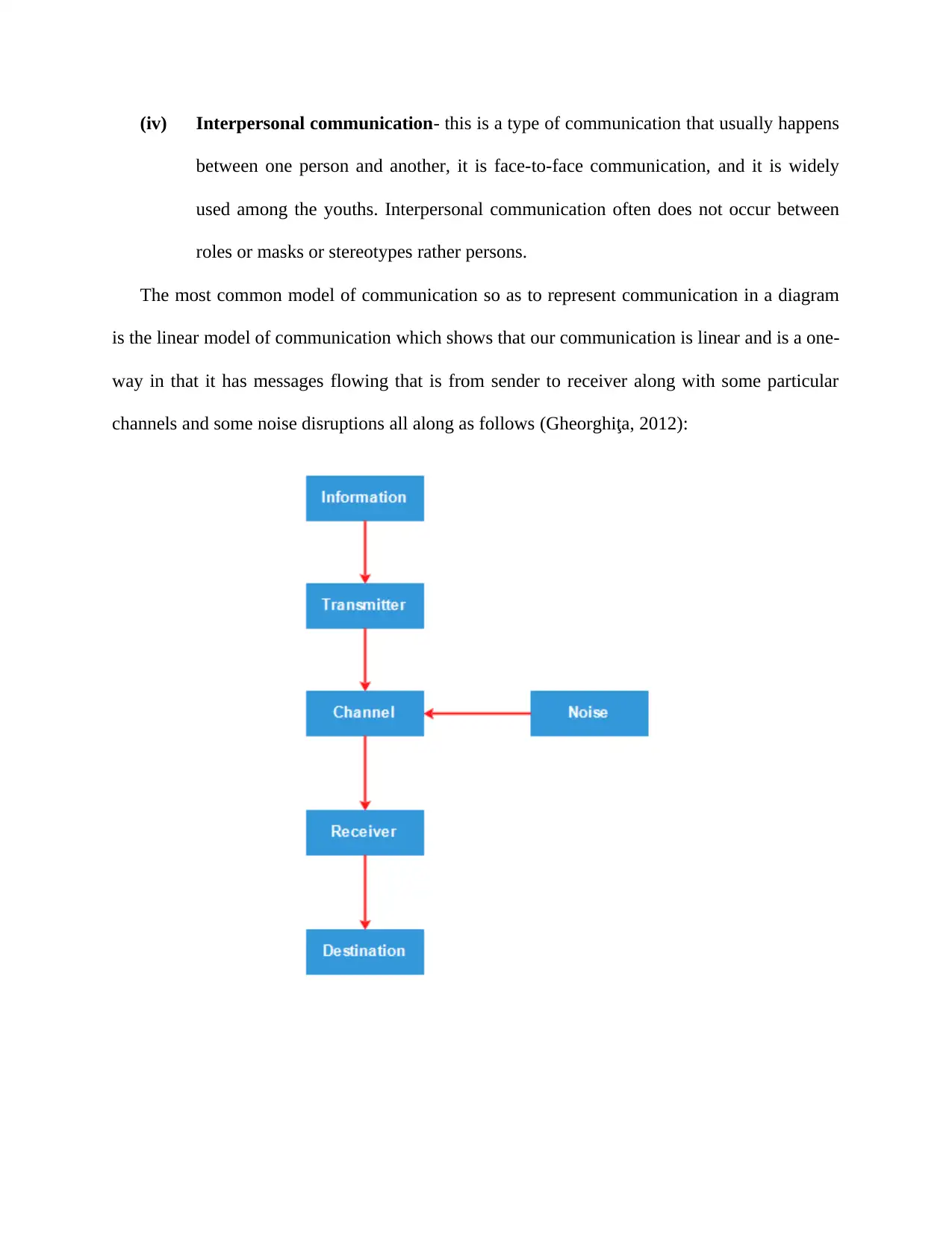
(iv) Interpersonal communication- this is a type of communication that usually happens
between one person and another, it is face-to-face communication, and it is widely
used among the youths. Interpersonal communication often does not occur between
roles or masks or stereotypes rather persons.
The most common model of communication so as to represent communication in a diagram
is the linear model of communication which shows that our communication is linear and is a one-
way in that it has messages flowing that is from sender to receiver along with some particular
channels and some noise disruptions all along as follows (Gheorghiţa, 2012):
between one person and another, it is face-to-face communication, and it is widely
used among the youths. Interpersonal communication often does not occur between
roles or masks or stereotypes rather persons.
The most common model of communication so as to represent communication in a diagram
is the linear model of communication which shows that our communication is linear and is a one-
way in that it has messages flowing that is from sender to receiver along with some particular
channels and some noise disruptions all along as follows (Gheorghiţa, 2012):
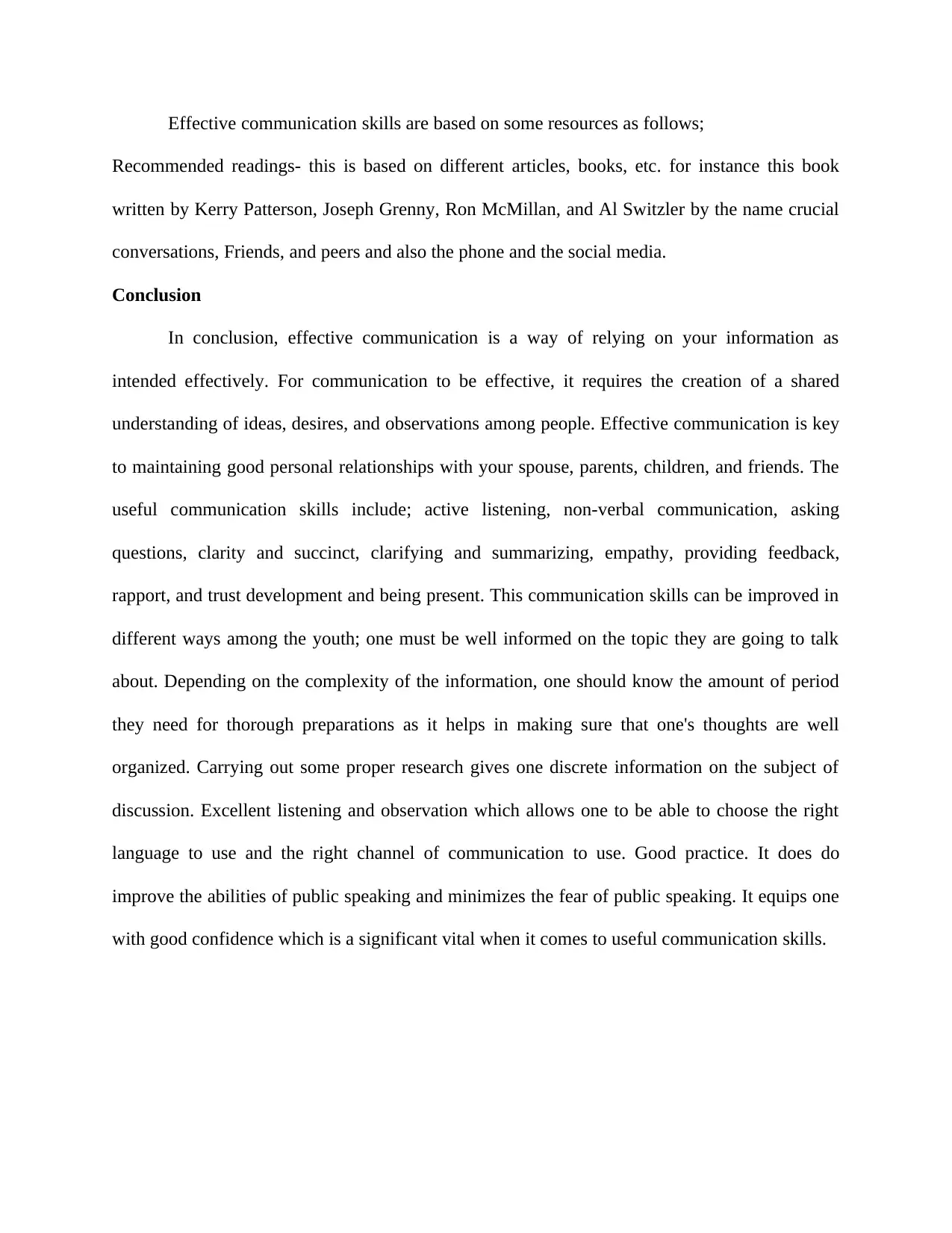
Effective communication skills are based on some resources as follows;
Recommended readings- this is based on different articles, books, etc. for instance this book
written by Kerry Patterson, Joseph Grenny, Ron McMillan, and Al Switzler by the name crucial
conversations, Friends, and peers and also the phone and the social media.
Conclusion
In conclusion, effective communication is a way of relying on your information as
intended effectively. For communication to be effective, it requires the creation of a shared
understanding of ideas, desires, and observations among people. Effective communication is key
to maintaining good personal relationships with your spouse, parents, children, and friends. The
useful communication skills include; active listening, non-verbal communication, asking
questions, clarity and succinct, clarifying and summarizing, empathy, providing feedback,
rapport, and trust development and being present. This communication skills can be improved in
different ways among the youth; one must be well informed on the topic they are going to talk
about. Depending on the complexity of the information, one should know the amount of period
they need for thorough preparations as it helps in making sure that one's thoughts are well
organized. Carrying out some proper research gives one discrete information on the subject of
discussion. Excellent listening and observation which allows one to be able to choose the right
language to use and the right channel of communication to use. Good practice. It does do
improve the abilities of public speaking and minimizes the fear of public speaking. It equips one
with good confidence which is a significant vital when it comes to useful communication skills.
Recommended readings- this is based on different articles, books, etc. for instance this book
written by Kerry Patterson, Joseph Grenny, Ron McMillan, and Al Switzler by the name crucial
conversations, Friends, and peers and also the phone and the social media.
Conclusion
In conclusion, effective communication is a way of relying on your information as
intended effectively. For communication to be effective, it requires the creation of a shared
understanding of ideas, desires, and observations among people. Effective communication is key
to maintaining good personal relationships with your spouse, parents, children, and friends. The
useful communication skills include; active listening, non-verbal communication, asking
questions, clarity and succinct, clarifying and summarizing, empathy, providing feedback,
rapport, and trust development and being present. This communication skills can be improved in
different ways among the youth; one must be well informed on the topic they are going to talk
about. Depending on the complexity of the information, one should know the amount of period
they need for thorough preparations as it helps in making sure that one's thoughts are well
organized. Carrying out some proper research gives one discrete information on the subject of
discussion. Excellent listening and observation which allows one to be able to choose the right
language to use and the right channel of communication to use. Good practice. It does do
improve the abilities of public speaking and minimizes the fear of public speaking. It equips one
with good confidence which is a significant vital when it comes to useful communication skills.
⊘ This is a preview!⊘
Do you want full access?
Subscribe today to unlock all pages.

Trusted by 1+ million students worldwide
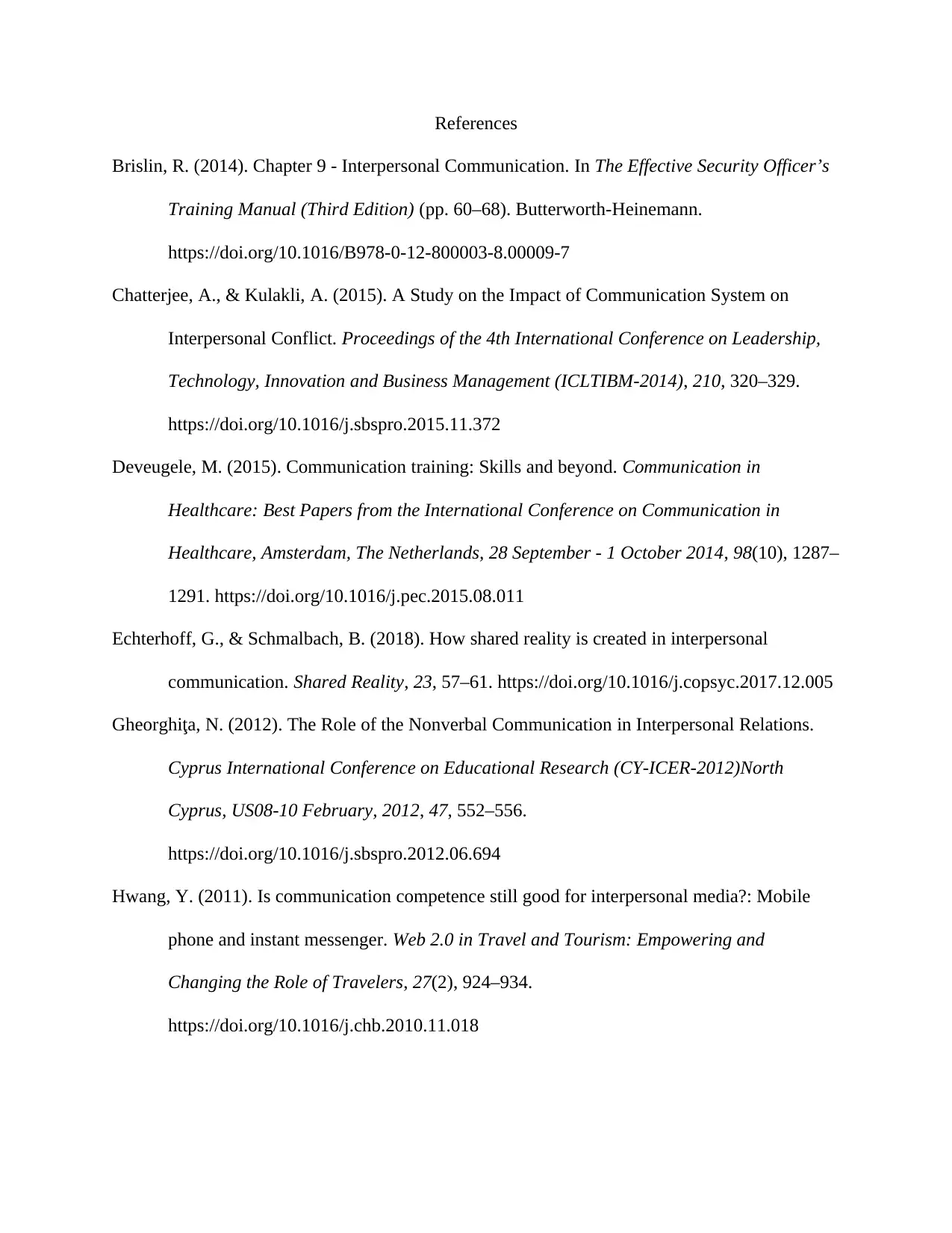
References
Brislin, R. (2014). Chapter 9 - Interpersonal Communication. In The Effective Security Officer’s
Training Manual (Third Edition) (pp. 60–68). Butterworth-Heinemann.
https://doi.org/10.1016/B978-0-12-800003-8.00009-7
Chatterjee, A., & Kulakli, A. (2015). A Study on the Impact of Communication System on
Interpersonal Conflict. Proceedings of the 4th International Conference on Leadership,
Technology, Innovation and Business Management (ICLTIBM-2014), 210, 320–329.
https://doi.org/10.1016/j.sbspro.2015.11.372
Deveugele, M. (2015). Communication training: Skills and beyond. Communication in
Healthcare: Best Papers from the International Conference on Communication in
Healthcare, Amsterdam, The Netherlands, 28 September - 1 October 2014, 98(10), 1287–
1291. https://doi.org/10.1016/j.pec.2015.08.011
Echterhoff, G., & Schmalbach, B. (2018). How shared reality is created in interpersonal
communication. Shared Reality, 23, 57–61. https://doi.org/10.1016/j.copsyc.2017.12.005
Gheorghiţa, N. (2012). The Role of the Nonverbal Communication in Interpersonal Relations.
Cyprus International Conference on Educational Research (CY-ICER-2012)North
Cyprus, US08-10 February, 2012, 47, 552–556.
https://doi.org/10.1016/j.sbspro.2012.06.694
Hwang, Y. (2011). Is communication competence still good for interpersonal media?: Mobile
phone and instant messenger. Web 2.0 in Travel and Tourism: Empowering and
Changing the Role of Travelers, 27(2), 924–934.
https://doi.org/10.1016/j.chb.2010.11.018
Brislin, R. (2014). Chapter 9 - Interpersonal Communication. In The Effective Security Officer’s
Training Manual (Third Edition) (pp. 60–68). Butterworth-Heinemann.
https://doi.org/10.1016/B978-0-12-800003-8.00009-7
Chatterjee, A., & Kulakli, A. (2015). A Study on the Impact of Communication System on
Interpersonal Conflict. Proceedings of the 4th International Conference on Leadership,
Technology, Innovation and Business Management (ICLTIBM-2014), 210, 320–329.
https://doi.org/10.1016/j.sbspro.2015.11.372
Deveugele, M. (2015). Communication training: Skills and beyond. Communication in
Healthcare: Best Papers from the International Conference on Communication in
Healthcare, Amsterdam, The Netherlands, 28 September - 1 October 2014, 98(10), 1287–
1291. https://doi.org/10.1016/j.pec.2015.08.011
Echterhoff, G., & Schmalbach, B. (2018). How shared reality is created in interpersonal
communication. Shared Reality, 23, 57–61. https://doi.org/10.1016/j.copsyc.2017.12.005
Gheorghiţa, N. (2012). The Role of the Nonverbal Communication in Interpersonal Relations.
Cyprus International Conference on Educational Research (CY-ICER-2012)North
Cyprus, US08-10 February, 2012, 47, 552–556.
https://doi.org/10.1016/j.sbspro.2012.06.694
Hwang, Y. (2011). Is communication competence still good for interpersonal media?: Mobile
phone and instant messenger. Web 2.0 in Travel and Tourism: Empowering and
Changing the Role of Travelers, 27(2), 924–934.
https://doi.org/10.1016/j.chb.2010.11.018
Paraphrase This Document
Need a fresh take? Get an instant paraphrase of this document with our AI Paraphraser
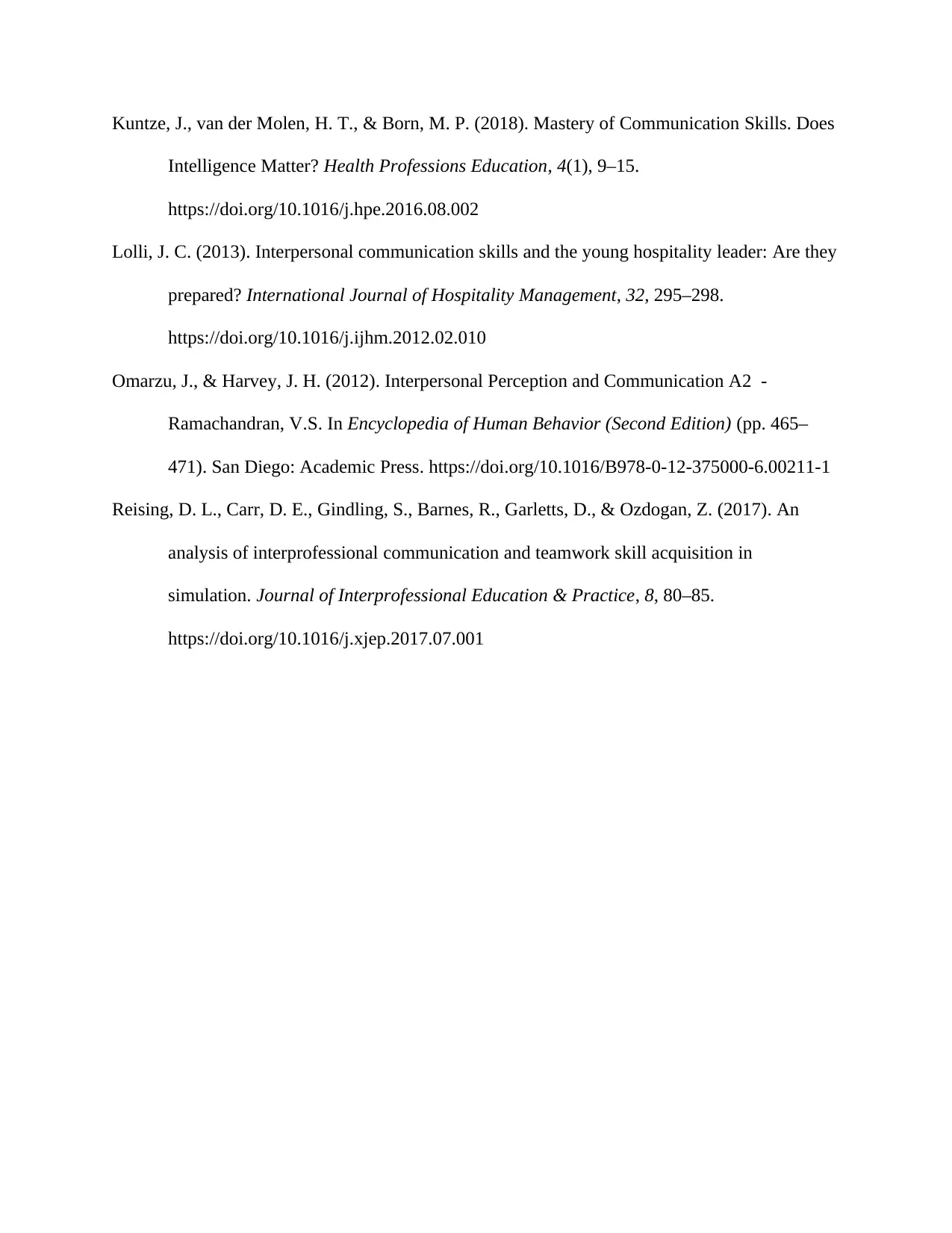
Kuntze, J., van der Molen, H. T., & Born, M. P. (2018). Mastery of Communication Skills. Does
Intelligence Matter? Health Professions Education, 4(1), 9–15.
https://doi.org/10.1016/j.hpe.2016.08.002
Lolli, J. C. (2013). Interpersonal communication skills and the young hospitality leader: Are they
prepared? International Journal of Hospitality Management, 32, 295–298.
https://doi.org/10.1016/j.ijhm.2012.02.010
Omarzu, J., & Harvey, J. H. (2012). Interpersonal Perception and Communication A2 -
Ramachandran, V.S. In Encyclopedia of Human Behavior (Second Edition) (pp. 465–
471). San Diego: Academic Press. https://doi.org/10.1016/B978-0-12-375000-6.00211-1
Reising, D. L., Carr, D. E., Gindling, S., Barnes, R., Garletts, D., & Ozdogan, Z. (2017). An
analysis of interprofessional communication and teamwork skill acquisition in
simulation. Journal of Interprofessional Education & Practice, 8, 80–85.
https://doi.org/10.1016/j.xjep.2017.07.001
Intelligence Matter? Health Professions Education, 4(1), 9–15.
https://doi.org/10.1016/j.hpe.2016.08.002
Lolli, J. C. (2013). Interpersonal communication skills and the young hospitality leader: Are they
prepared? International Journal of Hospitality Management, 32, 295–298.
https://doi.org/10.1016/j.ijhm.2012.02.010
Omarzu, J., & Harvey, J. H. (2012). Interpersonal Perception and Communication A2 -
Ramachandran, V.S. In Encyclopedia of Human Behavior (Second Edition) (pp. 465–
471). San Diego: Academic Press. https://doi.org/10.1016/B978-0-12-375000-6.00211-1
Reising, D. L., Carr, D. E., Gindling, S., Barnes, R., Garletts, D., & Ozdogan, Z. (2017). An
analysis of interprofessional communication and teamwork skill acquisition in
simulation. Journal of Interprofessional Education & Practice, 8, 80–85.
https://doi.org/10.1016/j.xjep.2017.07.001
1 out of 8
Related Documents
Your All-in-One AI-Powered Toolkit for Academic Success.
+13062052269
info@desklib.com
Available 24*7 on WhatsApp / Email
![[object Object]](/_next/static/media/star-bottom.7253800d.svg)
Unlock your academic potential
Copyright © 2020–2025 A2Z Services. All Rights Reserved. Developed and managed by ZUCOL.




